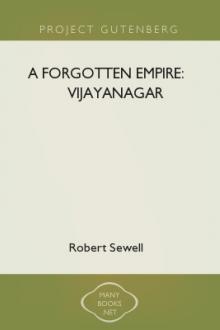A Forgotten Empire: Vijayanagar by Robert Sewell (short story to read TXT) 📕

- Author: Robert Sewell
- Performer: -
Book online «A Forgotten Empire: Vijayanagar by Robert Sewell (short story to read TXT) 📕». Author Robert Sewell
In 1573, therefore, Ali Adil moved against Dharwar and Bankapur. The siege of the latter place under its chief, Velappa Naik, now independent, lasted for a year and six months, when the garrison, reduced to great straits, surrendered. Firishtah346 states that the Adil Shah destroyed a “superb temple” there, and himself laid the first stone of a mosque which was built on its foundation. More successes followed in the Konkan. Three years later Bellamkonda was similarly attacked, and the Raya in terror retired from Penukonda to Chandragiri. This campaign, however, resulted in failure, apparently owing to the Shah of Golkonda assisting the Hindus. In 1579 the king of Golkonda, in breach of his contract, attacked and reduced the fortresses of Vinukonda and Kondavid as well as Kacharlakota and Kammam,[347] thus occupying large tracts south of the Krishna.
In 1580 Ali Adil was murdered. Firishtah in his history of the Qutb Shahs gives the date as Thursday, 23rd Safar, A.H. 987, but the true day appears to have been Monday, 24th Safar, A.H. 988, corresponding to Monday, April 11, A.D. 1580. This at least is the date given by an eye-witness, one Rafi-ud-Din Shirazi, who held an important position at the court at the time. (The question is discussed by Major King in the INDIAN ANTIQUARY, vol. xvii. p. 221.) Ibrahim Qutb Shah of Golkonda also died in 1580 and was succeeded by Muhammad Quli, his third son, who in 1589 founded the city of Haidarabad, originally carted Bhagnagar. He carried on successful wars in the present Kurnool and Cuddapah districts, capturing Kurnool, Nandial, Dole, and Gandikota, following up these successes by inroads into the eastern districts of Nellore.
King Tirumala of Vijayanagar was in 1575 followed apparently by his second son, Ranga II., whose successor was his brother Venkata I.[348] (1586). The latter reigned for at least twenty-eight years, and died an old man in 1614. At his death there were widespread revolts, disturbances, and civil warfare, as we shall presently see from the account of Barradas given in the next chapter. An important inscription of his reign, dated in A.D. 1601 — 2, and recorded on copper-plates, has been published by Dr. Hultzsch.[349]
In 1593 the Bijapur Sultan, Ibrahim Adil, invaded Mysore, which then belonged to the Raya, and reduced the place after a three months’ siege. In the same year this Sultan’s brother, Ismail, who had been kept prisoner at Belgaum, rose against his sovereign and declared himself independent king of the place. He was besieged there by the royal troops’ but owing to treachery in the camp they failed to take the place, and the territories in the neighbourhood were for some time a prey to insurrections and disturbances. Eventually they were reduced to submission and the rebel was killed. Contemporaneously with these events, the Hindus again tried to obtain possession of Adoni, but without success;[350] and a war broke out between the rival kingdoms of Bijapur and Ahmadnagar.
With this period ends abruptly the narrative of Firishtah relating to the Sultans of Bijapur. The Golkonda history351 appears to differ widely from it, but I have not thought it necessary here to compare the two stories.
The history of the seventeenth century in Southern India is one of confusion and disturbance. The different governors became independent. The kings of the decadent empire wasted their wealth and lost their territories, so that at length they held a mere nominal sovereignty, and nothing remained but the shadow of the once great name — the prestige of family. And yet, even so late as the years 1792 and 1793, I find a loyal Reddi in the south, in recording on copper-plates some grants of land to temples, declaring that he did so by permission of “Venkatapati Maharaya of Vijayanagar;”[352] while I know of eight other grants similarly recognising the old Hindu royal family, which were engraved in the eighteenth century.[353]
The Ikkeri or Bednur chiefs styled themselves under-lords of Vijayanagar till 1650.[354] A Vijayanagar viceroy ruled over Mysore till 1610, after which the descendants of the former viceroys became Rajahs in their own right. In Madura and Tanjore the Nayakkas became independent in 1602.
All the Muhammadan dynasties in the Dakhan fell under the power of the Mogul emperors of Delhi towards the close of the seventeenth century, and the whole of the south of India soon became practically theirs. But meanwhile another great power had arisen, and at one time threatened to conquer all India. This was the sovereignty of the Mahrattas. Sivaji conquered all the Konkan country by 1673, and four years later he had overthrown the last shreds of Vijayanagar authority in Kurnool, Gingi, and Vellore; while his brother Ekoji had already, in 1674, captured Tanjore, and established a dynasty there which lasted for a century. But with this exception the Mahrattas established no real domination in the extreme south.
Mysore remained independent under its line of Hindu kings till the throne was usurped by Haidar Ali and his son and successor, “Tippoo,” who together ruled for about forty years. After the latter’s defeat and death at Seringapatam in 1799, the country was restored by the English to the Hindu line.
The site on which stands Fort St. George at Madras was granted to Mr. Francis Day, chief factor of the English there, by Sri Ranga Raya VI. in March 1639, the king being then resident in Chandragiri.
The first English factory at Madras had been established in 1620.
CHAPTER 17
The Story of Barradas (1614)
Chandragiri in 1614 — Death of King Venkata — Rebellion of Jaga Raya and murder of the royal family — Loyalty of Echama Naik — The Portuguese independent at San Thome — Actors in the drama — The affair at “Paleacate.” — List of successors — Conclusion.
The following note of occurrences which took place at Chandragiri in 1614 on the death of King Venkata I. will be found of singular interest, as it relates to events of which we in England have hitherto, I think, been in complete ignorance. In consists of an extract from a letter written at Cochin on December 12, A.D. 1616, by Manuel Barradas, and recently found by Senhor Lopes amongst a quantity of letters preserved in the National Archives at Lisbon.[355] He copied it from the original, and kindly sent it to me. The translation is my own.
“I will now tell you … about the death of the old King of Bisnaga, called Vencattapatti Rayalu,[356] and of his selection as his successor of a nephew by name Chica Rayalu; setting aside another who was commonly held to be his son, but who in reality was not so. The true fact was this. The King was married to a daughter of Jaga Raya by name Bayama, and though she eagerly longed for a son she had none in spite of the means, legitimate or illegitimate, that she employed for that purpose. A Brahman woman of the household of the Queen’s father, knowing how strong was the Queen’s desire to have a son, and seeing that God had not granted her one, told her that she herself was pregnant for a month; and she advised her to tell the King, and to publish it abroad, that she (the Queen) had been pregnant for a month, and to feign to be in that state, and said that after she (the Brahman woman) had been delivered she would secretly send the child to the palace by some confidant, upon which the Queen could announce that this boy was her own son. The advice seemed good to the Queen, and she pretended that she was pregnant, and no sooner was the Brahman woman delivered of a son than she sent it to the palace, and the news was spread abroad that Queen Bayama had brought forth a son. The King, knowing all this, yet for the love he bore the Queen, and so that the matter should not come to light, dissembled and made feasts, giving the name ‘Chica Raya’ to the boy, which is the name always given to the heir to the throne.[357] Yet he never treated him as a son, but on the contrary kept him always shut up in the palace of Chandigri,[358] nor ever allowed him to go out of it without his especial permission, which indeed he never granted except when in company of the Queen. Withal, the boy arriving at the age of fourteen years, he married him to a niece of his, doing him much honour so as to satisfy Obo Raya, his brother-in-law.[359]
“Three days before his death, the King, leaving aside, as I say, this putative son, called for his nephew Chica Raya, in presence of several of the nobles of the kingdom, and extended towards him his right hand on which was the ring of state, and put it close to him, so that he should take it and should become his successor in the kingdom. With this the nephew, bursting into tears, begged the King to give it to whom he would, and that for himself he did not desire to be king, and he bent low, weeping at the feet of the old man. The King made a sign to those around him that they should raise the prince up, and they did so; and they then placed him on the King’s right hand, and the King extended his own hand so that he might take the ring. But the prince lifted his hands above his head, as if he already had divined how much ill fortune the ring would bring him, and begged the King to pardon him if he wished not to take it. The old man then took the ring and held it on the point of his finger offering it the second time to Chica Raya, who by the advice of the captains present took it, and placed it on his head and then on his finger, shedding many tears. Then the King sent for his robe, valued at 200,000 cruzados, the great diamond which was in his ear, which was worth more than 500,000 cruzados, his earrings, valued at more than 200,000, and his great pearls, which are of the highest price. All these royal insignia he gave to his nephew Chica Raya as being his successor, and as such he was at once proclaimed. While some rejoiced, others were displeased.
“Three days later the King died at the age of sixty-seven years. His body was burned in his own garden with sweet-scented woods, sandal, aloes, and such like; and immediately afterwards three queens burned themselves, one of whom was of the same age as the King, and the other two aged thirty-five years. They showed great courage. They went forth richly dressed with many jewels and gold ornaments and precious stones, and arriving at the funeral pyre they divided these, giving some to their relatives; some to the Brahmans to offer prayers for them, and throwing some to be scrambled for by the people. Then they took leave of all, mounted on to a lofty place, and threw themselves into the middle of the fire, which was very great. Thus they passed into eternity.
“Then the new King began to rule, compelling some of the captains to leave the fortress, but keeping others by his side; and all came to him to offer their allegiance except three. These were Jaga Raya, who has six hundred thousand cruzados of revenue and puts twenty thousand men into the field; Tima Naique, who has





Comments (0)